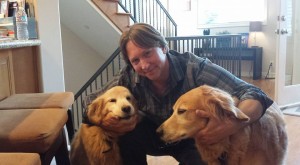Our first stop was Lawrence’s ranch atop Lobo Mountain. Dad makes a good tour guide, as long as he keeps his eye on the road. He has this habit of drifting into creative trances or flipping his notebook over the steering wheel to jot down brilliant lines that strike him.
Inspiration must have struck, because we almost missed the entrance off U.S. 64 as Dad skidded into a roadside cloud of dust and sagebrush. We got back on track and made the five-mile trek to the ranch, which spans 160 acres, offering amazing slingshot views into neighboring states. Lawrence spent a good part of the 1920s here when he had tuberculosis, hosting friends, writing his St. Mawr book and a lot of goose bump-laden poetry.
The grouchy caretaker pointed us toward his ashes, which rest in a small white chapel at the top of the steepest point. Every week or so, 10 to 30 devotees of Lawrence make pilgrimages here from across the world.
“Thanks for teaching me the proper way to eat a fig in society,” a Lawrence follower scribbled into the guest book.
Lawrence’s widow, Frieda, wanted his remains stored in an urn. His literary muse, Mabel Dodge Luhan, wanted them scattered. In a moment of triumph, Frieda dumped the ashes into a wheelbarrow filled with wet cement and blurted, “Now, let’s see them steal this.”
Lawrence exalted Taos, and Taos still exalts Lawrence, perhaps more than any other writer. The exception could be John Nichols, author of a string of spirited novels such as the The Milagro Beanfield War, The Nirvana Blues and On the Mesa.
If Nichols hasn’t documented every tumbleweed in the Taos valley, he’s come close. His books, a mix of ruminations about this wild territory and indictments of encroaching development, are displayed here like tourist brochures.
If you’re lucky, you can catch Nichols giving readings of his works at the Caffe Tazza coffee shop. We just missed him, but we did hear New Mexico poets Renee Gregorio and John Brandi howl some passionate verse, luring wide-eared tourists off the sidewalks and into the cafe’s orange light.
Near our Adobe Wall Motel, we wandered through the late Luhan’s estate. Luhan is the Taos luminary who gets credit for the genesis of Taos’ literary scene. She came here in 1916 and hosted scores of renegade intellectuals, artists and literary figures. It was Luhan who enticed Lawrence to come here.
Sitting on Morado Lane, the estate is a quiet, rambling 22-room adobe Eden that greets visitors with towering birdhouses shaded by cottonwood trees. Now it’s a hotel, where visitors can wander.
Any inventory of literary haunts should include the Taos Pueblo, a magnificent riddle of a communal village built around 1350 by the Pueblo Indians. Home to one of our country’s oldest Indian tribes, it ranks among the pyramids of Egypt, the Taj Mahal and Vatican City as a World Heritage Site.
Six kivas, or underground ceremonial chambers, are off limits to the public but have endured as a source of relentless spiritual investigation by writers. As one story goes, when the mountain peaks are shrouded in clouds, the Indians disappear inside them for mysterious rites.
Just what the Pueblos were up to nagged at both Lawrence and the Swiss psychologist Jung.
Lawrence was obsessed with the Indians’ beauty.
“Go to Taos pueblo on some brilliant snowy morning and see the white figure on the roof,” Lawrence wrote. “Or come riding through the dusk on some windy evening, when the black skirts of the silent women blow around the white wide boots, and you will feel the old, old root of human consciousness still reaching down to depths we know nothing of.”

